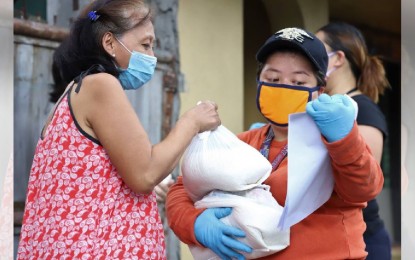
COMMUNITY RESPONSE TO COVID-19. A personnel of Barangay Sacred Heart in Quezon City extends food aid from the government in this April 9, 2020 photo. A board member of the Philippine Society of Public Health Physicians, in a webinar, recognized the essential role of communities in the overall response to Covid-19 and recommended a four-pronged approach. (PNA photo by Robert Oswald Alfiler)
MANILA – The involvement of communities in preventing and controlling the spread of the coronavirus disease 2019 (Covid-19) is a crucial strategy to address the pandemic.
An unprecedented health crisis of such a dramatic scale is a clear test of the Filipino bayanihan spirit, especially how our communities can work together to help the country survive and recover from its scathing effects.
The Philippine Society of Public Health Physicians (PSPHP) has recognized the essential role of communities in the overall Covid-19 response and recommended a set of practical and people-centric guides for community-based management.
The medical organization highlighted the necessity of community-based public health response, considering that 80 percent of Covid-19 patients will not require hospitalization and will need at most basic clinical care.
PSPHP board member Jaifred Christian Lopez said the community-based management of Covid-19 involves a four-pronged approach – local preparedness and response strategy; case finding and contact tracing; establishing community isolation units; and a family-oriented approach for different levels of care.
“There should be some specific mechanisms that we have to put up in our LGUs (local government units) that would facilitate collaboration, consensus, and capacity-building,” Lopez said in the webinar, LGU Management of Pandemics.
Local preparedness and response strategy
Communities should always be prepared to respond against Covid-19, and it begins with a swift and systematic assessment of the situation.
The PSPHP noted that proper risk assessment could guide LGUs in mounting the appropriate level of response against Covid-19.
These levels of response entail different priority actions that would then lead to efficient mobilization.
According to the PSPHP recommendation, the LISTO response level for LGUs with action objectives are the Alpha (establish the system); Bravo (implement the action plan); Charlie (intensify response); Charlie to Bravo (scale down and recover); and Bravo to Alpha (strengthen the system).
“We try to work with what we have. We don't have to reinvent the wheel. (This strategy) deals with how you can leverage the existing structures that you already have in your LGUs,” Lopez said.
He noted the importance of clear roles and organizational tasks in strengthening accountability and coordination for each level of response.
Case finding and contact tracing
Communities can prevent the spread of Covid-19 through community-mobilized and people-centric case finding, contact tracing, and isolation.
This is possible even in a setting of limited testing capacity.
The PSPHP underscored the key roles of the Barangay Health Emergency Response Teams (BHERTS) in detecting, managing, and monitoring cases at the community level.
The BHERTS are primarily responsible for active contact tracing and considered the malasakit (compassion) arm of communities in identifying at-risk populations, as well as linking people to the government with social safety nets.
Establishing community isolation units
The PSPHP has pushed for the Local Isolation and General Treatment Areas for Covid-19 (LIGTAs Covid), which is an alternative to home-based isolation in controlling the spread of the virus in communities.
LIGTAs Covid, as an isolation mechanism, is viewed as an essential component in breaking the chain of Covid-19 transmission.
The facility should have four operational considerations – space, staff, supplies, and services.
It should also meet the following requirements: function over form; acceptability of the community; cost-effectiveness and sustainability; and safety and security.
Among the services offered are the provision of accommodations for cohorts of mild confirmed cases of Covid-19, suspect or probable cases, as well as contacts; monitoring and symptomatic treatment of mild cases; prompt referral at the first signal of clinical deterioration; and discharge instructions and community reintegration.
Family-oriented approach for different levels of care
The PSPHP argued that the family can be an “enabler or a disabler” in the Covid-19 response.
Hence, it is necessary to assess their vulnerabilities and risk profile to prevent and manage Covid-19 infection in the community.
“Each person's actions are influenced by their home context and it impacts the Covid-19 chain of transmission,” the group said.
It noted that families have unique dynamics and members take on particular roles, such as decision-makers, caregivers, and health educators.
“Knowing these roles can help the BHERTS in assisting households (to) prevent and manage Covid-19 in the home and community setting,” the PSPHP said. “Home is the front line! A community-based approach enables the home.”
This four-pronged approach of community-based management puts the bayanihan spirit at the forefront in effectively preventing the spread of Covid-19.
It starts in our homes. It starts in our communities. (PNA)
